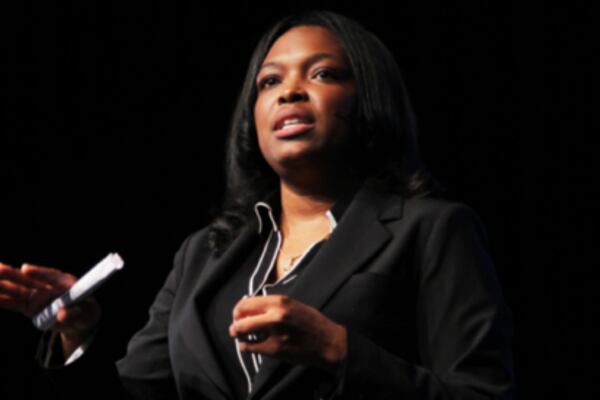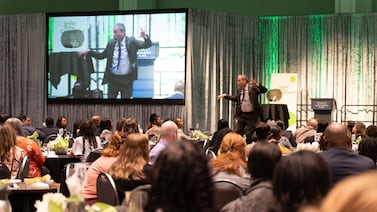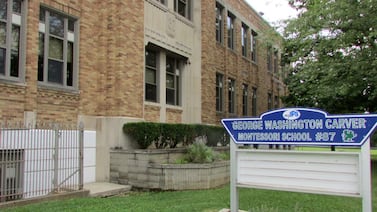Chicago schools chief Janice Jackson is poised for what could be the most turbulent stretch yet of an eventful tenure at the helm of the country’s third-largest district. After a spring of enormous disruption for the city’s schools, the district is gearing up for a fall reopening steeped in uncertainty and controversy. The district’s tentative plan to blend in-person and remote learning for most students has drawn harsh criticism from the teachers union — and numerous questions from parents.
Chalkbeat caught up with Jackson to talk about the lessons from the district’s foray into virtual learning this past spring and some of the fine print on the district’s fall plans.
This interview has been lightly edited for length and clarity.
Chalkbeat: The coronavirus crisis required school districts to shift gears abruptly. Are you second-guessing any of the decisions you made?
Janice Jackson: The short answer is no — definitely not second-guessing any of the decisions. If you had asked me in January how long it would take to put together a remote program, I would say 18 months to two years. And so we were able to stand up a program and provide training and support for teachers in a pretty short period of time. Now, granted, if this was a longer plan, with more deliberate steps and actions, of course we would see different outcomes. But I do think that the crisis propelled us in a way that I think is going to have a lasting impact on the district. We used to think of access to devices and broadband internet connectivity as a thing that’s nice to have. But what we now see is that this is essential for 21st-century education. Post COVID-19, we’re going to see access to devices and internet connectivity as important as access to textbooks.
I also think that we started out doing the thing that we were uniquely positioned to do. Schools act as a safe haven and a resource in all of our communities. Distributing over 15 million meals to families who were in insecure situations is something that I am incredibly proud of.
Also, the “Chicago Connected” program, which is seeking to provide high-speed internet access in the homes of 100,000 of our students over the next three years, is something that we were pushed to do as a result of our response to COVID. But I think that it’s the right thing to do.
It wasn’t perfect. We know it was incredibly challenging for families. I personally at the end felt like I completed fifth grade and eighth grade with my kids. Yes, it was a lot of work. But I think we really rallied. With that said, we have to plan for the future. There were a lot of lessons learned that we’re using in order to make sure we have a stronger remote learning program in the fall.
CB: What are those lessons?
JJ: One that really stands out to me is the need to codify and streamline practices across the district. We were all trying to figure things out. Some people were using Zoom; some people were using Google, all of which were good options, and people were working extremely hard. But in order for the district to have visibility, and also set goals and plan, we have to make sure that we have consistency in our processes. So we’ll be using the same platform for everybody in the fall, which will help us monitor remote instruction, allow principals to monitor what’s happening in their schools, and allow parents more visibility into what’s happening between their child and their teacher.
I also think that the necessity around access to high-speed internet was something that we learned — again, something that we always knew. But I think figuring out how to do that and provide that to families who were in difficult financial situations is something that we learned. One of the things that I think the district did well was our grading policy. Some of the practices that we put in place early on really helped us to monitor what students were doing and to motivate students and educators to engage in remote learning in a pretty aggressive way.
CB: Summer school is still underway, but do you feel so far that the district is successful in reaching students with its summer programs, particularly those who needed to make up some work from the spring?
JJ: I don’t have the numbers in front of me. That’s definitely something we can follow up on. But this was not a remediation program. For our students in elementary school, it’s really an opportunity to expand learning. We focused on students who had a poor start to remote learning. So this was a way to expand it and offer them access to a highly qualified teacher remotely, so that they can stay on track. This was also an opportunity to keep students engaged. It was an opportunity to stay true to our commitments around the extended school year for our diverse learner students.
At the high school level, students are recovering credit. And so far from the preliminary data, registration and participation in the program mirrors what it looked like in prior years. And it’s mainly because there’s a lot of motivation on the part of the students because they want to obtain those credits so that they can graduate.
I think that the fact that we’re offering summer school was a big lift. And I count that as a success. But we wanted to be flexible. There are some families where getting through the school year was tough enough, and they needed a break.
CB: Do you anticipate that the district might use this summer’s more centralized approach to providing a common digital curriculum in the fall as well? How would the district vet such online curricula?
JJ: We’ve made a commitment to create a fully aligned digital curriculum by 2022. (In 2019, Chicago announced a $135 million plan to create a centralized curriculum across multiple subjects.) That plan obviously would have been nice to have already completed at the time of COVID. But we were ahead of the game in thinking that this is necessary. With that said, we are making available the district curricula to everybody. It’s still in beta form. It’s not complete, but the materials that have been created and designed for CPS that would have ordinarily been tested out for the school year and modified with teacher feedback, we’re going to put that out to a larger group of teachers throughout the district.
It won’t be mandatory that they use it. Teachers can continue to use the curriculum that they have in place. Many of our schools have a plan and a curriculum that they have bought into, but there are also a lot of schools that don’t. This will be a resource that’s available to everybody. There’s training around that to support teachers. And I think that this is a good resource for teachers, many of whom have said they needed additional support, especially in the way of curriculum in order to do remote learning effectively.
CB: Let’s talk about the tentative plan to reopen schools in the fall. One of its key tenets is regular sanitation of school buildings. Parents and educators have raised school cleanliness as a concern in recent years, and that issue came up during a forum on the reopening plan this week. With higher stakes this fall, how will the district ensure schools are clean, and how will it hold its contractors accountable?
JJ: In our plan, we talked about our plans for continuing to ensure that our school buildings are clean. Of course, they’ve been closed for the past few months. So they all received deep cleaning in our preparations for students to return. But one thing I think that’s important to note is that the criticism is not as recent as I think the question purports. This was a problem two or three years ago, and we’ve made dramatic progress over time. We’ve hired more staff and for the upcoming school year, we’re actually bringing on an additional 400 janitors on top of the 2,100 I believe we already have on staff in our schools across the system.
We’ve also purchased equipment to help us clean our buildings in between class sessions and pods, so that the deep cleaning is occurring. For our hybrid model, we organized things so that for students who attend school on Pod A days, which will be Monday and Tuesday, there’s a break on Wednesday where everyone is home, so that we can allow for the type of deep cleaning in the schools without a lot of traffic in the building. And then those students who will be educated in Pod B will come in.
This is something that we’re committed to getting right.
CB: The district is giving families the choice to opt out of in-person instructional together. But those students will receive only one day of virtual instruction with their teachers. What do you say to students and parents who worry that’s just not enough?
JJ: We put together a plan that has as many options as possible for families. We also have to take into consideration the fact that our teachers can’t be in two places at one time. We know that in-person instruction is the most impactful way to educate students. And so this is one of the trade-offs. With that said, I think that our teachers will do a great job offering lessons, whether those lessons are recorded and posted for students so that they can have as much of a meaningful experience as possible. We have heard from a lot of our parents that they want more clarity around what a full remote option will look like, and we’re working through what that is. We also want to make sure that we’re providing support for our most vulnerable students, which is why our plan calls for full day in-person instruction for our students in pre-K and our cluster student programs. Those are two groups in particular where educating them in a remote setting was just not possible, and it didn’t really achieve the benefits that they would achieve in in-person instruction. We can’t have preschoolers in front of a computer for three or four hours a day. And likewise, our students in the cluster programs really benefit not only from the in-person interaction, but also from some of the socialization that they get as a result of being in school with their peers.
CB: The Chicago Teachers Union has sharply criticized the hybrid opening plan. How are you going to navigate this pushback from labor?
JJ: My focus will continue to be on providing a high-quality education for students. We’ve heard a lot of things about this plan. I hear from parents that want their kids back in school. I hear from parents who are concerned about returning to school. I think another point that is critical is that the essential workers that we’ve all celebrated throughout this pandemic are the parents of students in CPS, and they need an option. Many of them are working in sales, especially in Black and brown communities. Their students are the most vulnerable, and they know that the public school system provides a resource for them.
I’m sure CTU shares my concern about educating students, and we put together a plan to do both things: educate our students in a way that we know is the most effective but also keep them safe. What I said time and time again around this is that we figured out how to do a lot of essential and non-essential things during COVID. I count school as essential. And so it is really all of our responsibility — the district, CTU, everyone involved — we are all responsible for learning how to do this in this environment, because we will be in an environment where COVID is a threat for years to come. We’re taking a step forward and putting out a plan that represents our best thinking right now given what science is telling us. But that plan will be fluid and dynamic just as everything has been during this time.
CB: Mayor Lori Lightfoot said at the reopening plan’s unveiling that the plan is largely budget-neutral, which has drawn some jabs from the teachers union.
JJ: I clarified that after she spoke at the meeting. We are spending $75 million on our response to COVID. I think what the mayor was referencing is that we had spent $75 million the prior year on our response to COVID and maybe making a case that that was budget neutral.
CB: More generally, how concerned are you about the long-term financial implication of this crisis for the school district?
JJ: Like everyone, I worry about the financial implications of COVID, not just on the school system, but on our economy. But I want to be clear that our planning is not focused on that. We will do whatever it takes in order to educate our students and do this safely. I’m much more concerned about the long-term effects academically on our students, especially our most vulnerable students. I think that hasn’t gotten enough attention.
Despite our best effort through remote learning, remote learning is not equivalent to what you get when you have access to a teacher in front of you every single day, which is why our plan calls for multiple pathways. But we’re also strengthening the accountability and the monitoring system for our plan. As we transition into the fall, whether that is in-person or all remote, one thing that I’m committed to is increasing the level of accountability to ensure that our kids are actually learning and getting the education that they deserve.
CB: You mentioned recently that the district received an “overwhelming” response from high school juniors and seniors and their families who would like to see some in-person instruction in those grades. Are you still rethinking that portion of the plan?
JJ: We are going to be guided by the feedback that we get. And one of the things that we said is that it’s difficult to have more than a certain amount of students in a high school come back just by sheer virtue of how our schools are organized. There are far more students in high schools than in elementary schools, and they move around a lot more.
However, we do have a group of high schools that are in buildings that are under-enrolled, and it may be possible to bring back all of those students. These happen to be some of our students in the most economically depressed parts of the city, where having access to in-person schooling is not only beneficial academically, but it’s beneficial from a social standpoint in that the kids have a safe place to go. They can be actively engaged. We’ve also heard from a lot of our senior parents that if it is all remote, they still feel strongly that their children need touch points with their school and with their counselors, because they plan to apply to college and other post-secondary opportunities. So it’s definitely something that we’re looking at.
CB: Is the district putting some thought into how it can address issues of race and racism in the classroom this fall?
JJ: We’ve talked about how to strengthen our plan as it relates to social and emotional learning. We heard loud and clear through our initial survey results at the end of the year that this was a very traumatic experience, which was not a surprise. It was traumatic for me, so I know what it was like for our students and families. Making sure that we have a stronger support system for our students was one of the most important factors that went into this planning. So that looks like being very clear about access to counselors, social workers, and other related service providers in our schools.
During the spring, it took us a while to get that off the ground. We were able to launch that and make sure parents were aware of the support that they can receive, but it was a process. We’ll start the school year off in a much stronger place. CPS has long been a leader in supporting students and really changing the historical narrative around what has happened in our country and what continues to happen. We made civics a graduation requirement years ago. We were the first large school district across the country to adopt the 1619 Project Curriculum (based on the New York Times Magazine initiative to reframe U.S. history in a way that highlights the repercussions of slavery and the contributions of Black Americans). We are here to have these kinds of conversations. We’ve been really proud of some of the curriculum materials and resources that our civic engagement and social sciences has been able to put together. We’re unafraid of addressing those issues in our schools. We were talking about Black Lives Matter before it was popular. I’ve been really proud of educators and CPS, that there is a focus on high-quality instruction, but also one on social justice for our kids.







